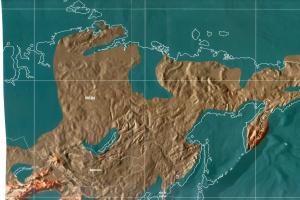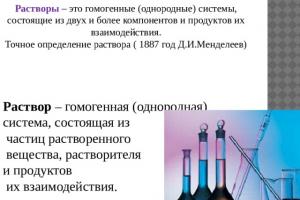The science
The more advanced technologies become, the more opportunities open up for scientists and the more we can learn about our Universe. Every year space reveals more and more of its secrets to us; in the near future we will probably learn something that we could not even guess about before. Find out what discoveries in the field of space have been made in recent years.
1) Another satellite of Pluto

To date, 4 satellites of Pluto are already known. Charon was discovered in 1978 and is its largest satellite. This moon's diameter is 1,205 kilometers, leading many scientists to believe that Pluto is actually a "double dwarf planet." Nothing new was heard about the icy bodies that orbit Pluto until 2005, when the space telescope "Hubble" I did not discover 2 more satellites - Nikta and Hydra. The diameter of these cosmic bodies is from 50 to 110 kilometers. But the most amazing discovery awaited scientists in 2011, when "Hubble" managed to capture another satellite of Pluto, which is temporarily called P4. Its diameter is only 13 to 34 kilometers. What is noteworthy in this case is that "Hubble" photographed such a tiny space object, which is located at a distance of about 5 billion kilometers from us.
2) Giant cosmic magnetic bubbles

Two NASA spacecraft "Voyager" discovered magnetic bubbles in the region of the solar system known as Heliosphere, which is located 15 billion kilometers from Earth. In the 1950s, scientists believed that this region of outer space was relatively flat, but when "Voyager 1" reached the Heliosphere in 2005, and "Voyager 2" In 2008, they detected turbulence generated by the Sun's magnetic field, where magnetic bubbles with a diameter of about 160 million kilometers are formed.
3) Tail of the star Mira A

In 2007, the orbiting space telescope GALEX scanned Mira A, an old red dwarf star, as part of an upcoming project to scan the entire sky in ultraviolet light. Astronomers were shocked when they discovered that Mira A has a long tail trailing behind it, like a comet, which extends about 13 light years. This star moves through the Universe at an unusually high speed, approximately 470 thousand kilometers per hour. Before this, it was believed that stars did not have tails.
4) Water on the Moon

October 9, 2009 NASA's Lunar Crater Observation and Sensing Spacecraft LCROSS discovered water in a cold and constantly shadowed crater at the south pole of the Moon. LCROSS is a NASA probe that was designed to collide with the lunar surface, and a small satellite following it would measure the chemical composition of the material that rose up on impact. After a year of data analysis, NASA has reported that our satellite has water in the form of ice, which is located at the bottom of this eternally dark crater. Later, other data showed that a thin layer of water covers the lunar soil, at least in some areas of the Moon.
5) Dwarf planet Eris

In January 2005, a new planet of the solar system, Eris, was discovered, which caused a lot of controversy in the astronomical world about what should be considered a planet in general. Eris was initially considered the 10th planet of the solar system, but then all objects in the Kuiper belt and asteroid belt were equated to a new class - dwarf planets. Eris lies beyond the orbit of Pluto and is about the same size, although it was originally thought to be larger than Pluto. It is known that Eris has one satellite, which was named Dysnomia. So far, Eris and Dysnomia are considered the most distant objects in the solar system.
6) Traces of water flows on Mars

In 2011, NASA, providing photographs of the Red Planet, made a statement that it had evidence that water may have flowed on Mars in the past, which left traces. Indeed, the images show long streaks similar to those left in the rocks by flowing streams. Scientists believe these currents are salt water that heats up during the summer months and begins to flow over the surface. Signs that Mars once had liquid water have been found before, but this is the first time scientists have noticed that these traces change over a short period of time.
7) Saturn’s moon Enceladus and its geysers

In July 2004, the spacecraft "Cassini" entered orbit around Saturn. After the mission "Voyager" approached this satellite, the researchers decided to launch another device into the area for a more detailed study of Enceladus. After "Cassini" flew past the satellite several times in 2005, scientists were able to make a number of discoveries, in particular, that in the atmosphere of Enceladus there is water vapor and complex hydrocarbon compounds that are released from the geologically active region of the South Pole. In May 2011, NASA scientists at a conference dedicated to this satellite stated that Enceladus can be considered the very first candidate for the discovery of life.
8) Dark Stream

The dark flow, discovered in 2008, has left scientists with more questions than answers. Clusters of matter in the Universe appear to be moving at very high speeds in the same direction, which cannot be explained by any known gravitational force within the observable part of the Universe. This phenomenon was called "Dark Stream". By observing large clusters of galaxies, scientists have discovered about 700 galaxy clusters moving at a certain speed towards the distant part of the Universe. Some scientists even dared to suggest that the Dark Stream moves due to pressure caused by another Universe. However, some astronomers dispute the existence of the dark stream altogether.
9) Exoplanets

The first exoplanets, that is, planets existing outside the solar system, were discovered in 1992. Astronomers have discovered several small planets orbiting the star Pulsar. The first giant planet was spotted in 1995 near the nearby star 51 Pegasus, which made a complete revolution around this star in 4 days. By May 2012, 770 exoplanets were already registered in the Encyclopedia of Exoplanets. 614 of them are part of planetary systems and 104 are multiple planetary systems. By February 2012, NASA mission "Kepler" identified 2,321 unconfirmed exoplanet candidates associated with 1,790 stars.
10) First planet in the habitable zone

In December 2011, NASA confirmed reports of the discovery of the first planet that is located in the habitable zone, orbiting its Sun-like host star. The planet was named Kepler-22b. Its radius is 2.5 times the radius of the Earth, and it orbits its star in a zone suitable for the emergence of life. Scientists are not yet sure about the composition of this planet, but this discovery was a major step towards discovering Earth-like worlds.
Scientific discoveries cannot be foreseen, that’s why they are discoveries, but you can at least point to those probable areas and areas of science where progress can most likely be expected. "Country" provides a list of scientific breakthroughs and discoveries that the scientific community expects in the next year.
1. 3D model of the Universe
On board the GAIA telescope is the largest digital camera ever created in the world: it can capture stars whose radiance is 400 thousand times fainter than those stars that can be seen by the human eye.
The GAIA telescope is incredibly accurate: many scientists compare that if you install it on the surface of the Moon and point it at Earth, you will be able to see the silhouette of a person.
The telescope monitors billions of stars, measuring their speed, magnitude, position and distance from Earth. Based on the data received from the GAIA telescope, a 3D model of our galaxy (Milky Way) will be compiled, thanks to which we will be able to understand a lot about its origin and evolution, discover new cosmic bodies, and identify tens of thousands of asteroids.
2. Expedition to the Moon
In the new year, the Chinese intend to send the unmanned spacecraft Chang'e-5 to the Moon, which will deliver 2 kilograms of lunar soil to Earth. The last time such a trick was performed was in 1976, when the Soviet interplanetary station Luna-24 brought 170 grams of soil and rocks from the surface of our satellite. They were precious in the literal sense of the word: the cost of shipping one gram is estimated at $7 million. But thanks to these very tests, the existence of water on the Moon was discovered... The Chinese are not going to stop there and in 2018 they intend to make another breakthrough: to land a probe on the far side of the Moon. Neither the USA nor the USSR succeeded in this.
The goals of China's lunar program are preparation for the commercial development of the Earth's satellite. In particular, according to Professor Ouyang Ziyuan, head of the Chinese space program, huge reserves of the helium-3 isotope have been discovered on the Moon. It can be used as fuel in fusion reactors. These reserves are enough to provide humanity with energy for the next 10 thousand years.
3. Searches for extraterrestrial civilizations
On August 21, 2017, the United States is expected to experience a rare total solar eclipse that will be visible across the entire width of the continent, from Oregon to South Carolina. It is the first total eclipse visible only from the United States since the American Revolution and spans the country from coast to coast for the first time in 99 years. It will be completely available for observation in a strip 100 km wide for two or more minutes. Partially - from anywhere in North America, Hawaii and some areas of northern South America.
Using an ever-growing array of telescopes called the Event Horizon Telescope, astronomers will scan the interior of our Galaxy. If all goes well, we will see the first image of the Milky Way's supermassive black hole, known as Sagittarius A*.

The world's largest Chinese 500-meter telescope
But scientists will not stop there. This year, China completed construction of the world's largest telescope, and is serious about detecting signs of extraterrestrial civilization in space. More realistic goals include using FAST (Five-hundred-meter Aperture Spherical Telescope) to search for pulsars and other known objects in the galaxy.
In general, experts call the study and exploration of space one of the priority areas in the development of humanity in the near future, along with the creation of artificial intelligence.
4. Breakthrough in artificial intelligence
Full-fledged, autonomous artificial intelligence (AI), according to experts, should be developed within the next 5-10 years. Significant progress in the development of the so-called is planned for the coming year. deep neural networks and modern machine learning methods, which will help us get closer to creating AI of a completely new level. 2017 is expected to surprise us with the results of the application of machine learning and machine intelligence in a variety of areas.
First of all, this is the development of new self-learning algorithms, thanks to which robots will be able to improve themselves. Some progress in this direction has already been made: this year the AlphaGo program The AlphaGo program, developed by a Google subsidiary, DeepMind, beat the world champion in Chinese checkers Go with a score of three to zero. The champion was shocked.

AlphaGo became the first program in the world to win a head-to-head match against a professional Go player.
A similar experiment is already planned for next year. This time - with the computer game StarCraft II. The same Google company DeepMind announced a project to train artificial intelligence (AI) in this game. Experts plan to create a system that can defeat the current champions. The developers will present the first version of the AI for playing StarCraft II in February 2017. The program will be available to everyone and will allow them to create their own projects based on it. DeepMind hopes that in the future the application will allow solving problems in the real world.
The main goal in the development of new neural systems is to create a system that can adapt “on the fly” to a new complex task or environment, improve itself, self-learn and make decisions - just like the human brain.
“As we all remember from high school, the sign of the end of the industrial revolution is the moment when “machines begin to produce machines.” Perhaps in the future, the same important milestone will be the moment when neural networks begin to train neural networks, and there is reason to believe that this will happen already in 2017,” writes Dmitry Vetrov, research professor at the Department of Big Data and Information Retrieval, Faculty of Computer Science at the Higher School of Economics, in his column.
Neural networks will also learn to speak with humans, and computer translators will improve, language barriers will gradually disappear (some researchers predict that it will no longer be necessary to learn foreign languages - when communicating in real time, the computer will provide high-quality simultaneous translation). Robots will gradually begin to replace humans in some jobs (in particular, call center operators). Robots are already writing texts and music, and apparently, already next year this may become a routine for humanity.
5. Quantum computer
Global corporations (such as Google and IBM) and major research centers are working on creating quantum computers, the performance of which is millions of times higher than that of conventional machines.
Why are quantum computers needed? The fact is that the current generation of machines can no longer cope with the volume of data and the number of operations that a person requires from it. Soon, experts predict, everything will be connected to the Internet - from a blast furnace to a refrigerator, which will purchase food on its own. To manage all this, a new class of computers is needed.
Google has already boasted that its D-Wave quantum computer has learned to count 100 million times faster than a conventional computer. However, it is not yet possible to use these machines in everyday practice. Analysts suggest that the new year could be a turning point in this matter.
6. Green energy
Google promises to surprise the world not only with new developments in the field of AI, but also in the field of energy. So, next year Google plans to switch the power of its own data centers to alternative sources of electrical energy.
The Internet giant owns the search engine of the same name, the largest video hosting YouTube, the analytical service Google Analytics, the mapping service Google Maps and the Gmail mail service. In terms of volume of information, the company's database ranks 13th in the world, so the equipment for storing and processing data consumes a huge amount of energy. Therefore, Google decided that solar power plants and wind generators would generate “green energy” for the company’s data centers.
In addition, Saudi Arabia promises to show new developments in the field of alternative energy at the EXPO 2017 exhibition (The theme of the exhibition is “Future Energy”).
The Kingdom has decided to completely eliminate the use of fossil fuels by 2040. Traditional oil and coal must be replaced by alternative energy sources - solar energy and wind power. To this end, over the next 20 years, the KSA leadership intends to invest $109 billion in the development of solar energy infrastructure. The plans indicate the production of up to 41 gigawatts of energy from solar stations by 2040.
In general, at the international exhibition EXPO 2017, which will be held in Astana, many scientific discoveries in the field of green energy are expected. More than 100 countries and international organizations, and 2-3 million visitors will take part there.
7. Self-driving cars
Experts have long been saying that soon the professions of driver and taxi driver will disappear: cars will be able to drive themselves. These predictions are not groundless.
Over the past year, Tesla and Google have been testing their self-driving cars in real road conditions, and are already releasing the first models on the road. In 2017, self-driving cars will appear in 30 US cities. In Seattle, even a driverless 70-passenger bus will hit the road.

This is what Google's self-driving car looks like
“We're looking at places like college campuses, theme parks, airports, inner-city areas to test self-driving cars,” Corey Clozier, a spokesman for the consulting firm Comet, which is coordinating testing of self-driving cars, told the New York Observer. “It's like an elevator: you enter, indicate your destination, the doors are closed, let's go."
By the way, it is interesting that simultaneously with the start of testing of driverless cars, an unexpected study appeared, according to which driverless cars will help generate billions of dollars into the country’s economy - due to the fact that their owners will have more time for online shopping.
American Ford is not lagging behind Tesla and Google: the company will present its self-driving cars based on Ford Fusion and Mondeo in January 2017.
Norwegian authorities also intend to allow testing of driverless cars on public roads in 2017. From March, driverless cars will hit the roads in Australia.
The first unmanned vehicles, which can be rented on a short-term basis, will be tested next year in Moscow. In the Russian capital, they are going to combine taxis and carsharing cars into one service (Carsharing is a type of short-term car rental with a per-minute or hourly payment, usually used for short intracity trips - editor's note). Such cars will be able to operate both in normal manual mode and in fully self-driving mode. But for mass use, such unmanned vehicles will be available in Moscow no earlier than 2018-2019 - only tests are planned for 2017.

Ukrainian unmanned vehicle based on the Jeep Cherokee SUV
Ukraine is also not lagging behind in the development of the latest technologies: this year the first domestic autopilot Pilotdrive, developed by the Zaporozhye company Infocom LTD, has already been announced in Kyiv. The Ukrainian autopilot is able to recognize road markings, road signs, pedestrians and animals running onto the roadway, and can also navigate where there are no roads. But the main thing is that Pilotdrive is an unmanned vehicle piloting system that can be installed in all cars. However, exact information about the start dates for testing the system in road conditions has not yet been provided.
8. Revolutionary electric cars
The first electric car of the Zhiche Auto brand debuted in China. This is a “green” company (also in the sense that its creation history is less than two years old), like some others with Chinese roots, plans to produce a car with revolutionary characteristics.
The name of the young company is translated from Chinese as “wise car,” but its developers have not yet given a name to their first child, a single-volume electric crossover. The founder of the company, Shen Hain, believes that in the future, electric cars will become faithful assistants to their owners, and certain routine functions can be transferred to them. The novelty of his proposed approach to building cars is similar to that of modern manufacturers of mobile devices.

The new generation electric car will hit the market next year
Experts have developed the concept and design of a “smart” autonomous city electric vehicle connected via cloud technologies to other transport, infrastructure and even the owner’s home. An oval steering wheel, a multimedia tablet instead of a gearbox, no rear-view mirrors - instead there are two cameras that transmit images to two small displays at the corners of the front panel. And, of course, the electric crossover is equipped with an autopilot.
"Wise Cars" should go on sale in 2017. And of course, you can buy them online.
9. Rescue Robot
The Institute of Technology in Genoa is developing a robot that can act during natural disasters to save lives and eliminate serious consequences.
In the future, the Walk-Man robot can be used in extreme situations instead of people, and it is from people that it is now learning to move and walk. Today he still needs human guidance, but in the near future he will be able to assess the level of danger, environmental conditions, make decisions and act independently.
The Walk-Man project team is currently working on the robot’s software: it is necessary to improve its balance when moving on uneven surfaces.
A new step for the Walk-Man robot will be a serious test planned for the end of next year. Representatives of the Italian Civil Protection Service will be present. The robot will be sent to a building on fire, its mission is to find and save people.
10. Changing the human genome
Biotechnology company Editas Medicine, which is actively supported by Bill Gates, has officially announced that it will be able to edit the human genome in 2017. The technology that allows this manipulation is called CRISPR/Cas9. It is assumed that with the development of this technology, scientists will be able to overcome hereditary diseases. In this case, the gene that causes the disease will be corrected at the stage of embryo development.

Geneticists plan to experiment with this technology to combat diseases such as cancer and HIV. CRISPR can help treat blood cancer - leukemia. Instead of looking for a bone marrow donor, you can take tissue samples from the patient's own hematopoietic organ, correct the defective stem cells, ridding them of the fatal mutation, and then transplant them back. If the malignant cells remaining in the diseased body are destroyed by radiation, the corrected cells will be able to multiply and produce healthy blood cells.
Many scientists even believe that the new method of precise gene editing will make it possible to create a perfect person in the future. Using the CRISPR-Cas system, breaks can be introduced so as to remove an entire section of DNA. In this case, geneticists slip in a sequence they created, which is inserted in place of the deleted one. In this way, it is possible to “repair” mutations that cause severe diseases.
Photo: twitter/ S paceX @ SpaceX
In 2017, the world moved closer to a sci-fi future, from regenerating human cells to grow organs to creating a 51-qubit quantum computer—and the year isn't over yet.
Here are the 9 most significant discoveries in the last 8 months, according to Hightech.
1. Human embryo “edited”

On July 27 in Portland, Oregon, scientists made a significant breakthrough in gene editing technology. Using CRISPR, they successfully removed a gene associated with heart disease from a human embryo.
2. Metallic hydrogen created

On January 27, scientists created metallic hydrogen for the first time in science by applying nearly five million atmospheres of pressure to liquid hydrogen. In its metallic state, hydrogen can act as a true superconductor, a technology that will revolutionize many fields from energy storage to rocket science.
3. A habitable planet has been discovered

On April 19, scientists from the European Organization for Astronomical Research found the best planet for extraterrestrial life. LHS 1140b was discovered in the habitable zone of a dim star 40 light-years from Earth.
4. CRISPR edited genes inside the human body

Photo: National Institute of Allergy and Infectious Diseases, National Institutes of Health
On June 1, scientists used CRISPR gene editing technology (the most affordable gene editing technique) in the human body for the first time. The new study aimed to remove human papillomavirus (HPV) from 60 women by using a gel containing the necessary DNA coding for the cervix to disable the tumor's growth mechanism.
5. New technologies will allow growing organs

Photo: Wake Forest Baptist Medical Center
On May 1st, advances were made in the field of regenerative medicine. The Wake Forest Institute for Regenerative Medicine is currently leading projects to grow human organs and tissues. Its researchers' discoveries could help repair nerve damage and even regrow entire limbs and internal organs.
6. Google taught AI to adapt to complex environments

On July 11, Google's artificial intelligence division, DeepMind, published a paper illustrating how its experts train AI algorithms to adapt to complex and changing environments.
7. SpaceX relaunched a “spent” rocket

On March 30, SpaceX successfully launched and landed a used Falcon 9 rocket into orbit. This breakthrough further increased the affordability of space launches - saving more than $18 million per launch.
8. An artificial uterus was created

TBILISI, January 3 – Sputnik. An interstellar asteroid, a clone of the solar system, a breakthrough in gravitational astronomy, the secrets of the Egyptian pyramids, independent artificial intelligence, as well as other significant discoveries of scientists that changed the world in 2017 - in the RIA Novosti selection.
A new window to the Universe
The LIGO detector team detected gravitational waves resulting from the collision of two neutron stars in one of the galaxies of the Hydra constellation. The collision produced a burst of gamma rays, radio waves and X-rays that attracted the attention of scientists around the world who are still studying them. The discoverers themselves received the Nobel Prize in Physics almost before the discovery. The fact is that they discovered another burst of gravitational waves back in 2015, for which they should have been awarded. However, the signal about a new burst reached Earth two months before the annual award ceremony.
This discovery changed the views of scientists on the structure of space and time, as well as on the entire Universe in general.
©AFP/ESA
DNA to order
Two major discoveries related to genomic and molecular medicine became a sign that humanity has entered a new era of genetic engineering. Both are associated with changes in the DNA structure of embryos, but look at them from different angles.
One of the discoveries is the first successful editing of the genome of embryos, which made it possible to replace the defective gene responsible for cardiac hypertrophy with its normal version. Accordingly, such an operation, according to American scientists from the Massachusetts Institute of Technology (USA), can protect children from illness and death.
The second discovery was made as a result of experiments with full-fledged embryos. Scientists wanted to understand which genes play a vital role in the first stages of its development. As a result, they were able to turn off one of the key genes associated with stem cells, and also revealed its role in embryo development.
Both of these discoveries, according to biologists, will save many people from congenital diseases and significantly reduce the number of eggs required for successful artificial insemination.
Quantum breakthrough
Mikhail Lukin, a Harvard physicist and one of the founders of the Russian Quantum Center, together with his scientific group, created the first quantum computer, which includes 51 qubits - the elementary computing cell of quantum computers.
Thanks to the new device, physicists were able to uncover new quantum effects, the existence of which they previously had no idea about. They also hope to build more complex machines made from hundreds of qubits that could reveal the nature of quantum phenomena and help understand whether similar analog computers can be used to solve serious practical problems.
Development of artificial intelligence
Throughout the year, scientists from all over the world have been studying and improving artificial intelligence and machine learning systems.
For example, in January, the artificial intelligence AlphaGo participated as a human in the online championships of the ancient Chinese strategy Go. He defeated all the strongest players with a crushing score.
Later, the AlphaZero algorithm independently studied chess without human intervention and after a day of work was able to beat the previous algorithm, which was considered the champion in the ancient game.
In addition to table games, poker has also been introduced to artificial intelligence. In December, American scientists created a new algorithm that won almost two million dollars from online games. Artificial intelligence also studies various human hobbies: fine arts, music and cinema. So, in the summer, Russian programmers presented a system that writes music in the style of Scriabin and Nirvana.
Guest from other worlds
The automated PAN-STARRS telescope at the University of Hawaii made a sensational discovery in October, detecting the first comet to enter the Solar System from the interstellar medium - from Alpha Centauri. The asteroid 'Oumuamua immediately became the object of research by astronomers from all over the world.
Its appearance helped to study an object that was born in a distant star system and traveled around the worlds for several million years. Despite its similarity with asteroids and dwarf planets of the solar system, it was still radically different from them. In addition, scientists tried to find traces of an alien civilization or any radio transmitters on it, but found nothing.

© photo: AFP 2019 / NASA
Secrets of Egypt
The most scandalous discovery that caused controversy in the scientific community was the discovery of physicists from France and Japan. Using special telescopes and scanners that analyze objects for the presence of voids and secret rooms, they discovered two previously unknown areas inside the Cheops pyramid, where, in their opinion, the tomb of Pharaoh Khufu and his wife may be hidden.

© photo: Sputnik / Andrey Stenin
However, Egyptologists have criticized their conclusion as they do not believe that there could be anything else hidden inside the world's most studied pyramid. Japanese and French physicists were called “pyramidiots” and stated that the voids found were ordinary holes between stones.
Ecumenical dispute
Astronomers from the H0LiCOW project have released an independent estimate of the expansion rate of the universe, confirming last year's assumptions that it is expanding 8-10% faster than current calculations show.
However, astrophysicists and cosmologists are in no hurry to agree with their research and revise the Big Bang theory. Many people do not recognize the results of these observations. However, representatives of both opinions hope that with the help of other discoveries they will be able to prove their opponents wrong.
A pig on the outside, a man on the inside
The famous Harvard molecular biologist George Church, together with his scientific group, was able to raise pigs whose internal organs and all body cells were cleared of retroviruses that are dangerous to humans.
The problem was that initially, when viral sections were removed from DNA, animal cells self-destructed en masse. After five years of working on this problem, they were able to solve it.
Scientists hope that in the future it will be possible to create pigs with organs that will be completely suitable for humans and will not cause rejection. This will solve the big shortage of donors for sick people.
Solar System Clone
NASA, together with the European Southern Observatory, has discovered a star system that contains seven Earth-like planets. It is located 40 light years from the Sun and is considered a prime candidate for the presence of extraterrestrial life.
According to observations, these planets may have water, and the activity of the star is too weak to cause serious harm to living organisms. Of course, not everything is so smooth - the planets may turn out to be simple volcanic worlds that have lost their atmosphere due to the strong magnetic field of the star.
Despite this, it is planned to launch the James Webb telescope into orbit, the purpose of which will be to search for water and traces of life on the planets of this system.
December is the time to take stock. The editors of the Vesti.Nauka project (nauka.site) have selected the 15 most interesting discoveries that astronomers have pleased us with in the past year.
Observing the source of gravitational waves through telescopes
Artistic depiction of a neutron star collision.
For the first time in human history, it was possible to catch electromagnetic waves (including visible light) from a source of gravitational waves. This significant event occurred on August 17, 2017.
Visit of an interstellar asteroid

'Oumuamua was first considered a comet, then an asteroid. It has now been finally established that it is, after all, a comet.
In October 2017, astronomers discovered an object that... Further observations showed that it was an asteroid. It was given the name 'Oumuamua in honor of the Hawaiian deity.
Unlike all asteroids known to mankind so far, this “celestial stone” is not part of the solar system. He arrived from the interstellar abysses and is leaving our planetary system at full speed.
Asteroid threat warning system testing

Artistic depiction of an asteroid on its way to Earth.
While Oumuamua is peacefully leaving the solar system, it is circling in close proximity to the Earth. It's no wonder that humanity wants to be prepared for an uninvited visit.
On October 12, 2017, asteroid 2012 TC4 approached Earth. But a few weeks before that, the attentive eyes of specialists were already watching him. Scientific centers around the world exchanged information, and even the US government was notified as part of the exercise.
Meanwhile, it was known in advance that the cosmic block did not threaten the Earth with a collision. The 2012 TC4 was used as a "target" for testing the warning system. Our project is about these unusual teachings.
Determining the age of Jupiter

Artistic depiction of Jupiter.
Jupiter is the oldest planet in the solar system. This is exactly the result the researchers obtained when they finally managed to find out the age of the giant. And the most ancient part of the planet is its solid core.
Of course, scientists would not be able to “get to the bottom” of it. Chemical analysis of “stones from the sky” came to the aid of researchers. We are talking about the connection between the gas giant and iron meteorites.
The Greatest Explosion in the Observable Universe

The nature of the cosmic cataclysm is not yet known.
This is exactly how one can describe an event recorded by astronomers. The energy release of 2.3 × 10 52 erg is indecently high even for a supernova.
At a distance of 2.4 billion light years from Earth, something unprecedented happened. Scientists could not explain this either by the activity of the nucleus of a distant galaxy or by the activity of a black hole. However, they have versions, and we know which ones.
By the way, experts believe that such an explosion is not the only one of its kind. They had been observed before, but due to the enormous distances they were unable to assess the scale of the phenomenon.
Supernova that exploded several times

Artistic depiction of a supernova explosion.
This would seem to be impossible. A supernova explosion is an irreversible process that turns a star into a cloud of gas. Nevertheless, this is exactly how the iPTF14hls flash behaved. Its brightness increased several times, at its peak reaching a value of 3.5 billion Suns.
Astronomers do not yet have an explanation for this phenomenon, as well as many other mysterious features of the process that can be found.
The TRAPPIST-1 system and a planet ideal for life

Artist's rendering of the star LHS 1140 and its planet.
Three planets around the star TRAPPIST-1 in the constellation Aquarius were found back in 2016. Well, 2017 turned out to be rich in details.
Firstly, there were a total of seven planets. Secondly, it turned out that . However, not everything is so rosy: it seems that the star’s magnetic field is .
By the way, interesting planets were discovered not only in the TRAPPIST-1 system. Another discovery by scientists, the planet LHS 1140b, looks very tempting: the conditions on it are, in a sense, ideal for life. We're talking about why she's so good.
Discovery of water reserves on Earth's twins

Spitzer observed the TRAPPIST-1 system for more than 500 hours and learned a lot about it.
An even more intriguing discovery was made by Hubble in 2017. He discovered water on the planets of the already mentioned star TRAPPIST-1!
Of course, we are not talking about the fact that astronomers saw ocean waves. The telescope recorded a cloud of hydrogen, which experts believe is generated by the decomposition of water under the influence of ultraviolet radiation.
We are talking about how much water the planets of the system have already lost and which of these worlds still have enough life-giving moisture.
Hottest exoplanet

Artist's rendering of the star KELT-9 and its planet.
Not all worlds discovered in the past year can be called cozy. KELT-9b is certainly not a resort. The day side of the planet heats up to more than four thousand degrees Celsius. It is the hottest exoplanet known to mankind.
We're talking about this burning hell.
First observation of the atmosphere of an Earth-like planet

Artist's rendering of the star GJ 1132 and its planet.
Records excite the imagination, but humanity is still primarily interested in potentially inhabited worlds. Here GJ 1132b has a radius of only 1.4 Earth's. By the way, it is located quite close: only 39 light years from Earth.
By observing this world in seven different wavelength ranges, astronomers discovered its atmosphere. This is the first direct observation of a gas envelope in terrestrial exoplanets, although it is clear that many of them must have one.
From the project "Vesti.Nauka" (nauka.site) you can find out what gases, according to scientists, this atmosphere consists of.
X-ray signal from dark matter

An image of the Perseus cluster, where the mysterious signal came from.
The exciting discoveries of 2017 concerned not only other planets, but also the most hidden secrets of the structure of the world. Perhaps astronomers managed to catch a signal from a mysterious substance, which, according to cosmologists, accounts for 27% of the total energy of the Universe. Humanity knows about its existence only due to the gravitational effect of this matter on visible matter.
But now things have probably changed. And the reason for this is X-ray quanta with an energy of 3.5 kiloelectronvolts, coming from a distant cluster of galaxies. We are talking about the complicated history of this discovery and why dark matter was suspected of emitting this radiation.
The most distant and ancient object in the visible Universe

Quasars are located at enormous distances from the Earth and are original beacons, literally and figuratively illuminating the distant past of the Universe.
This is the title that the discovered quasar with a redshift of 7.5 deserves. All previous records have been broken. The light of the “ancient monster” was emitted just 690 million years after the Big Bang (which occurred, remember, 13.8 billion years ago).
This discovery puzzled scientists a lot. "Vesti.Nauka" why.
The death of the Cassini spacecraft

Artist's depiction of the Cassini spacecraft flying over Saturn.
On September 15, 2017, an event occurred that saddened all people who were interested in space exploration. The probe, which had been studying Saturn and its moons for more than 13 years, entered the dense layers of the giant’s atmosphere and collapsed.
This was not an accident, but a deliberate destruction of a working apparatus. We talk about what made scientists do this, and about the glorious space odyssey of the probe. By the way, later engineers
Artist's rendering of a black hole, accretion disk and jet.
Just recently, astronomers received unique images of a mysterious object. It is located very close (by cosmic standards) to the black hole at the center of the Milky Way and looks like a long thin thread.
The nature of the strange celestial body is still unknown. We are talking about hypotheses put forward by scientists. Among them is a very bold one: the discovery may confirm string theory.
Let's hope that 2018 will be just as rich in astronomical discoveries, and we will tell you a lot more interesting things.








